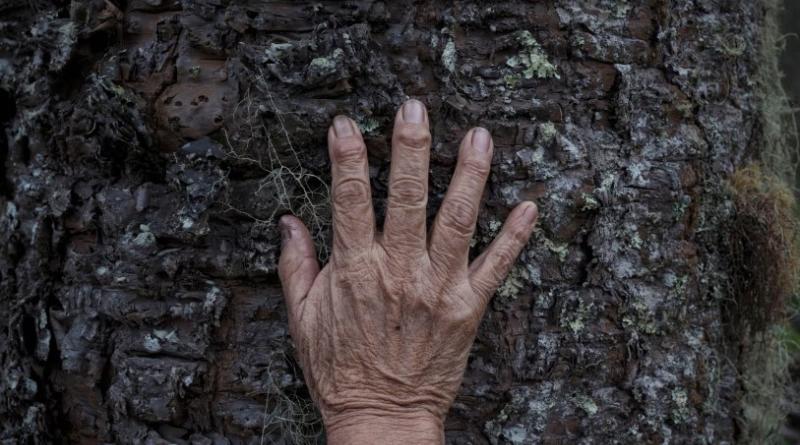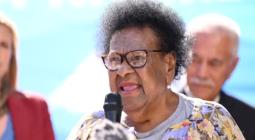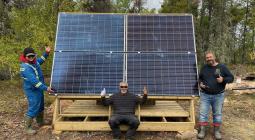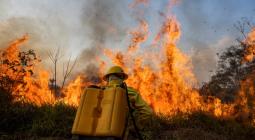‘It is all about listening and sharing’: Indigenous solutions to the carbon divide

Like most climate heroes, Francy Baniwa does not consider herself anything of the sort. A writer and activist of the Baniwa people from the Alto Rio Negro Indigenous territory in the Brazilian Amazon, she is part of a community of 25,000 people which protects an area of rainforest the size of Scotland.
Thanks to the presence and nature-immersed cultures of these traditional forest residents, this enormous area of vegetation and rivers in the state of Amazonas is more resistant than public land to invasions by ranchers, loggers, miners and other extractive industries. This has global benefits of carbon sequestration, regional benefits for rainfall generation and cooling, and local benefits for the abundant wildlife, such as jaguars, anteaters and anacondas that provide the inspiration for Francy’s books.
Caring for the forest is not a paying job for the 23 different Indigenous peoples that live in this area of 30,000 sq miles (80,000 sq km). They look after it because it is not just home, but family. “As a Baniwa woman, I am determined to protect this incredible place,” Francy says. “It’s not just for humans. We are all animals. Even the rivers and rocks are alive. The forest is a collective space.”
Values of collectiveness, empathy and spirituality are rarely part of the discussion in the global climate debate. They are hard to quantify, which means policymakers and economists discount or ignore them. According to Francy, this is where “white” capitalist society has gone wrong: “Nature is talking, but most of humanity has stopped listening,” she said. “White society doesn’t know how to listen to the forest as if it is a part of their own body, or a close relative. They see it only as money.”
The sharp end of the great carbon divide is all too apparent in her homeland. Most of the residents have a low income and tiny CO2 emissions. Factor in the role they play in looking after the forest and – even with the growing use of motorboats, motorboats, internet, TV and refrigerators – many people still lead net-positive lives.
Yet, they are on the burning frontline of the climate crisis. For decades, Indigenous pajé (a kind of shaman) have warned that something terrible is happening, that the seasons are becoming confused, that the termites are flying at an unusual time, that dry periods are longer and drier than usual, and the rains are causing more floods. This El Niño year has been brutally difficult. Downstream, the Rio Negro has shrunk to levels not seen since records began 120 years ago. Residents have complained that the water feels like it is boiling.
“Dolphins and fish are dying, the rivers are drying up, the forest is on fire and there is so much smoke in the air that we can’t breathe properly,” Francy says.
Compared with even 10 years ago, the voices of the world’s 370 million Indigenous people have grown louder in international forums, not just because of their suffering, but due to a wider recognition that they are an important part of the solution.
In Brazil, the Indigenous intellectual Ailton Krenak has gained traction by arguing that the first peoples are better equipped to cope with catastrophe because they have been living with apocalypse for the 500 years since the first Europeans invaded their land. In his new book, Life is not Useful, he writes: “The world is slowly, even if belatedly, awakening to the fact that Indigenous peoples, who are under threat, have valuable life experiences to share.” The essence of his approach is that capitalist selfishness is part of the problem. “I’m not going to save myself from anything alone. We are all in trouble … Either you hear the voices of all the other beings that inhabit the planet alongside you, or you wage war against life on Earth.”
The Brazilian government appears to be listening much more than in the past. Since Luiz Inácio Lula da Silva retook power at the start of the year, there have been demarcations of eight Indigenous lands and, for the first time in Brazil’s 500-year history, the creation of a new ministry of Indigenous peoples, which is organised according to biomes. “There has been an improvement in the outside world’s willingness to listen to us, but it is a different matter if they are acting on it,” said Joenia Wapichana, the first Indigenous head of the Indigenous affairs agency. “We need to be more involved in the climate change debate.”
There is a growing body of data that underscores the importance of Indigenous peoples in the climate fight. They manage at least 22% of the world’s forest carbon, and 36% of the planet’s “intact forest”. Deforestation rates are two to three times lower in Indigenous territory than in other types of forest, according to the World Resources Institute. Other studies have show that demarcation of Indigenous land is one of the most cost-effective ways to sequester carbon. In Brazil, the estimated benefits – of pollination, flood control, water supply, soil retention and recreation – of secure indigenous territories is estimated to be between $523bn to $1.16tn (£417bn to £930bn) over 20 years, compared with management and support outlays of less than 1% of this amount.
Such financial analyses run contrary to the traditional way of thinking of many Indigenous peoples, but they are not a monolith. Within communities, there are often divisions between those who want to maintain the forest and those who want to exploit it. Clóvis Moreira Saldanha, the mayor of São Gabriel da Cachoeira, which is the municipality encompassing most of Alto Rio Negro, is an Indigenous goldminer who wants to open up more land to resource extraction. He is a reminder that the desire of Indigenous people to protect the forest cannot be taken for granted. That depends on the interplay between traditional culture and the capitalist economy. For hundreds of years, the pressure has almost always been in one direction. The climate crisis is prompting some in capitalist economies to rethink and put a higher value on Indigenous science, philosophy and social organisation, but this has yet to go mainstream.
Francy Baniwa is determined to make that change, not just as a cultural defence mechanism, but out of sympathy for what she sees as the sad lives in white, urban, materialist culture. “I want to make them stop and realise they have enough. We want a happier world, where we can breathe freely, drink fresh water and collect fruit from the forest. This is a good life. But when I go to the city, I feel a great emptiness when I imagine all the life that used to be on the land before it was destroyed. It shocks me. I feel a loss of collective spirit, of people doing things together. It is essential for me not to lose my sense of collectiveness, to feel connected to my ancestors, to my children, to the forest around me. That is what I fight for. That is what I live for. It is all about listening and sharing.”
Photograph: Daniel Marenco/The Guardian





